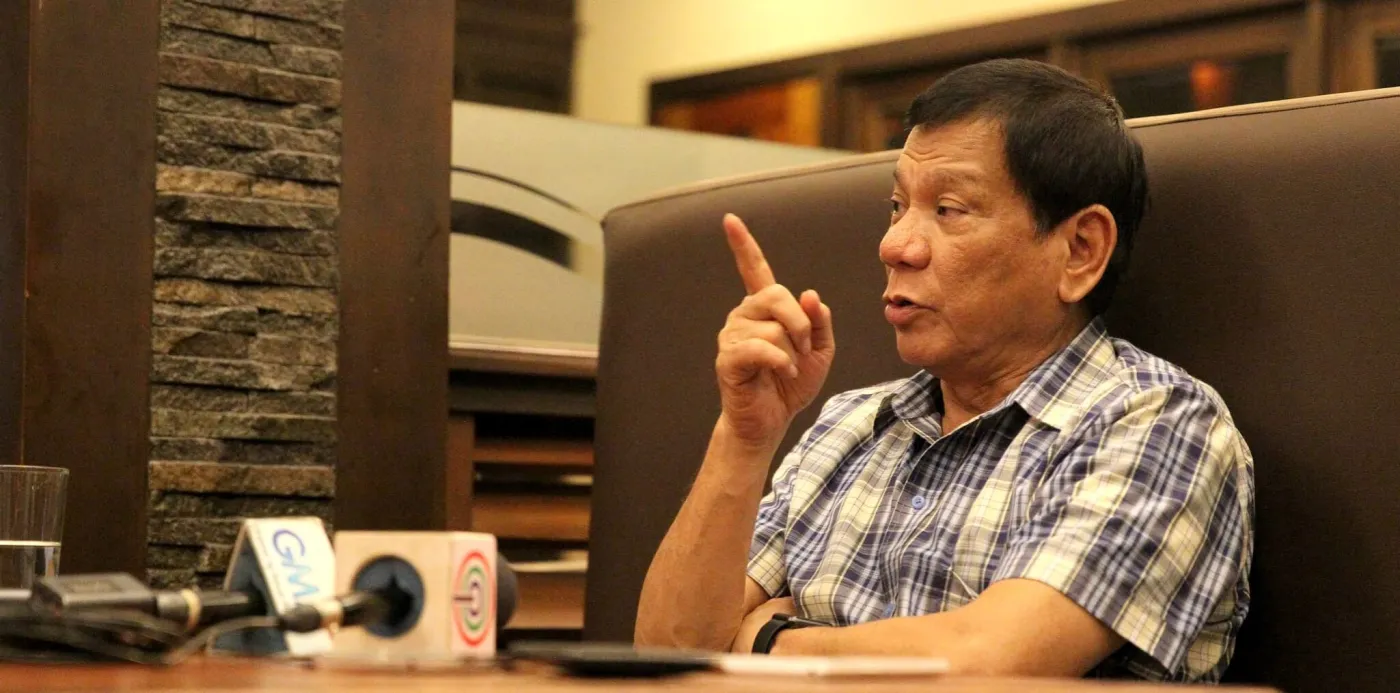Year One: How Mindanao journalists see Duterte
Covering Duterte

Year One: How Mindanao journalists see Duterte
STELLA A. ESTREMERA
July 21, 2017 ( CJJ11 )
STELLA ESTREMERA, editor-in-chief of Sun.Star Davao, tells how they understood Rodrigo Duterte in his messages to constituents, says journalists need to look beyond what he actually says for the real meaning, and asserts she and her colleagues in Davao were no less critical of him when he was their mayor
DAVAO—The three decades of covering President Rodrigo “Digong” R. Duterte first as an OIC then his 28 years as elected official can be an exercise in getting the right context to a story.
What he is saying today, we have already heard several times before and because he has been saying these for years now, he tends to go straight to the action and not the predicate. As Duterte himself said during one of his midnight press conferences in Davao City after the 2016 elections: “Do not believe everything I say. If it sounds preposterous, itanong mo yang media sa Davao, ‘Ano ba ito?’ Sasabihin sa inyo, ‘Niloloko lang kayo niyan.’” (Ask the Davao media, “What’s this?” They’ll tell you, “He’s just pulling your leg.”)
For as long as you anchor yourself on what has been said and done before, then you’re on your way to getting a better grasp of what Duterte is saying. Warning: it can be as far back as the Islamization of Mindanao, starting at around the 10th century way before Ferdinand Magellan landed in the Visayas.
The President always sets a predicate to whatever action or declaration he makes. If the subject puts up a fight, shoot. If your life is put in danger, kill. He’d rather go to the Spratlys by himself on a jetski and let China do whatever it wants to do with him than send the soldiers to a war they are bound to lose. But mainstream media would only bear down on the action and forget the predicate. That is what triggered his boycott of the media and the full engagement with the government communication facilities.
One channel source
But, Dabawenyos are used to listening to the mayor through one channel. His Sunday program “Gikan sa Masa, para sa Masa” on ABS-CBN Davao was the source of declarations and statements for more than 15 years.
Every Sunday, people watched the program and got their dose of expletives. It’s in “Gikan” where Duterte spilled out whatever he intended to do. Although he did have press conferences and allowed interviews on any other day, most of the time, he’d just be repeating what he already said.
The President as mayor was the city’s source of information and expletives delivered in a manner that engaged and entertained. He’d deliver punch lines with a straight face and never bothered about being politically correct. Through those 15 years on TV and more years in person, people learned to discern what was said in jest and what was serious matter.
There were no production numbers. There was just Duterte and a host facilitating the discussion. The ending would always be a greeting to his children, which later included grandchildren. Dabawenyos did not need anything else to make them listen for one hour every Sunday. The show’s rating was always in the double digits.
“This means, mataas ka talaga,” said new ABS-CBN Davao manager Christy Navacilla-Garcia, who at one time also hosted the show.
When there were controversial issues, the show even hit as high as 37 percent viewership, which Garcia said was very high “for a non-prime daytime Sunday show.”
When he sent someone else to discuss other topics, viewership would drop by around four percent within the first 15 minutes of the show, and that was not just Davao City watching.
ABS-CBN Davao’s signal is strongest in Davao City and the provinces of Davao del Norte and Davao del Sur. It gets patchy in Davao Oriental but also has a strong signal in the Cotabato provinces.
The ratings show that people want to listen to their leader.
Faith and trust
“Erosion of faith and trust in government—that is the real problem that confronts us. Resulting therefrom, I see the erosion of the people’s trust in our country’s leaders; the erosion of faith in our judicial system; the erosion of confidence in the capacity of our public servants to make the people’s lives better, safer and healthier.” This was how Duterte diagnosed what afflicts the country in his inaugural address.
Throughout the 22 years he was mayor, problems and situations were always given practical solutions. (He was vice mayor for three years and congressman for another three years for a total of 28 years as an elected politician). Personal stories have been shared in the earlier posts in #MyDuterteStory manifesting that faith and trust.
He took over the helm of the city when Davao was the urban laboratory of the communist guerrilla movement and one of its most populous districts, Agdao, was referred to as Nicaragdao, comparing the violence there to the bloody overthrow of the Somoza Regime in Nicaragua between 1978-79 to the bloodier Contra War of the 1980s. There was even a barangay in Agdao named Barrio Patay (Village of the Dead). It’s now been renamed Barpa.
Policemen were shot on the streets; militants were “salvaged” or disappeared. The “sparrows” (the New People’s Army Special Partisan Armed Unit or Sparu) were very active, and so were the military “assets” (civilian informers). Even the Alsa Masa, the movement spearheaded by the police in inner city settlements that was credited to those associated with the Civilian Home Defense Forces, the predecessor of the Civilian Armed Forces Geographical Unit, were abusing their powers. Then there was the Moro unrest.
Language of the left
Mayor Duterte spoke the language of the left, the Moro people, the uniformed, and the criminals. He reached out in peace to those who were rebelling. He instilled pride in the uniform and punished the scalawags, and he dealt with criminals not just with his tongue but also through police crackdowns. He was both harsh and giving, but always had the heart and the focus on “the common good.” He has often said that there should be no one in Davao who goes to sleep hungry. So every Monday, there is a distribution of rice and canned goods outside the City Hall for the very poor, and the free carnival rides at the park, lugaw (rice porridge), and ice cream every Christmas are additional treats.
In his first midnight press conference after the elections last May 16 at Hotel Elena in Lanang, Davao City, he was non-committal about whatever actions the government may take with regard to China. But he was very clear that war was not an option. He does not intend to waste both resources and lives of the Filipinos in this conflict at the West Philippine Sea, but he hinted that he may take a less conventional action.
“I cannot give you any other answer now except that all my answers will really be what is good for the Filipino and what is good for the country. Ako personally wala na eh. My mouth is insignificant, if we consider where we are now you and I. I cannot afford to sit with any group where you have to talk about a wrong and illegal and unlawful (act). I will be offended,” he said.
Where he’s coming from
A city struggling for peace and some positive vision of the future in 1988 found a leader in Duterte, who promised and delivered peace and order. But it took some messy turns.
As the communist rebels were pushed back to the hinterlands, crime spiked. The city had its share of heinous crimes: a toddler and a grandmother raped and killed, young children smashed to death, crimes of the drug-crazed. It was in the early 1990s when bodies of suspected criminals surfaced, some hogtied, others just disposed of by the roadside with paper or cardboard on which words were written along the lines of: “Hold-upper ako, huwag tularan. Davao Death Squad. (I’m a hold-upper. Do not imitate).” Hold-upper, snatcher, drug addict, rapist, whatever. There was always that note, and witnesses would always say that the killers rode “big bikes.” The reference was not lost on the people. At that time, Duterte was always riding his big bike.
But investigations, whether by the police or civil society, hit blank walls. No witness would testify; no family member sustained a protest, except one: Clarita Alia, whose three sons were killed as teenagers. But she herself did not witness the killings and no case has been filed in court. Sun.Star Davao was among the very few local news outfits that had a focused coverage on the movement against summary executions in the mid-2000s, but nothing has come of it. Dead ends were everywhere, except one in the early 2000s who was convicted for murder. I only knew him as John, a former bodyguard of a businessman who died of a disease several years before that. John’s link to the DDS was never established.
With crime rising as people were no longer afraid of going out of their homes even at night, availability of alcoholic drinks was regulated. This was on the premise that youths were staying out late to drink and more crimes were happening in the wee hours of the morning. That was in 1994 (City Ordinance 1627 series of 1994). This was moved up to 1 a.m. by 2014.
In 1994, the 10th Davao City Council passed City Ordinance 2491, the Davao City Children’s Welfare Code authored by erstwhile Davao City Councilor Leonardo R. Avila III. While it provided for a comprehensive children and family support system, it is better known for one provision (Section 18): the curfew for children below 15 years old unaccompanied by parents or guardians, which starts at 10 p.m. up to 4 a.m. In the early years, many children were abused by law enforcers, which again, Sun.Star Davao reported on and monitored. This has been stopped because of the active engagement of the community.
Central 911
The other significant ordinances that put order in the city were Ordinance 1406-02 or the firecracker ban (initiated as an executive order in 2001), which prohibits all kinds of pyrotechnics and firecrackers, resulting to zero casualty; and Ordinance 0367-12 or the Anti-Smoking Ordinance, which prohibits smoking in all public places; and Executive Order 4 series of 2013, which sets speed limits based on Republic Act 4136 or the Land Transportation and Traffic Code enacted on June 20, 1964, following road collisions that killed many.
The backbone of all this is the Central 911 and the Davao City Public Safety and Security Center established in 2002, which is able to respond to all types of emergencies within minutes (including saving stranded cats and loud videoke singing at past 10 p.m.) and enables law enforcers to solve crimes in a matter of days, for as long as these are reported and monitored by the high-resolution CCTV cameras scattered in key intersections and areas of concern in the city. Crime prevention has been enhanced by the people’s trust in the police, to whom anything is reported—from petty quarrels to suspicious strangers.
No, we do not live in a garrison, as others claim. What we have is faith in a government that has always worked for the greater good of the city and its people and has not corrupted power.
There are some gripes from the business sector who clamor for a government-initiated economic program. But because the peace and order has made the economy thrive and boom, these rumblings do not gain ground.
“As a lawyer and a former prosecutor, I know the limits of the power and authority of the president. I know what is legal and what is not,” Duterte said in his inaugural speech. “My adherence to due process and the rule of law is uncompromising. You mind your work, and I will mind mine.”
Just in case you’re wondering, he does not tell media what to write. Nor does he threaten journalists (as far as I know). 


“We in Davao press haven’t been too soft on Duterte”
Interview with Stella A. Estremera by Pachico A. Seares
Davao journalists seem to enjoy the reputation of being experts in covering Duterte, having watched and reported on his work as mayor for more than 15 years. “Itanong mo yang medya sa Davao. Sasabihin sa inyo, ‘Niloloko lang kayo n’yan.’” He also said not to believe him if he exaggerates or when he jokes. “Understand his mouth,” a journalist suggested. You advised to “get the context of the story” and don’t leave out “the predicate.”
But how does that kind of reporting work? Won’t that make the reporter the news source’s filter and arbiter on what was meant from the things the news source said?
Journalism is a discipline of verification. Aren’t we supposed to always get the context, the background, the truth about a story? Aren’t we supposed to not believe everything we hear? There are stories and there are “istorya lang.” You can always ask to clarify what he says because you sense you’re being taken for a ride or something is said in jest.
It’s 20 years of him as a politician who shuns formalities. Just about everyone is comfortable with him. He’s the type who sits down with anyone: journalists, poor people, “lumads,” businessmen etc. to talk and banter with. He’s comfortable as he is, and in return people are comfortable with him. Bantering is part of the whole conversation, interaction
Every news source has his sore spot. Duterte blew his top over a news correspondent’s question about his health. From your experience, what would usually set off the then mayor’s fuse?
Questioning his credibility. Saying something can’t be done. Being made to repeat himself (don’t worry, he will repeat himself over and over anyway).
Haven’t you and your colleagues in Davao, as some journalists outside that city seem to believe, been too soft on Duterte? No or little criticism, good press most of the time, no or sparse report on unsolved killings, no probing on any irregularity or anomaly. Does that sum up the coverage, or do outsiders get it all wrong?
I don’t believe (we Davao journalists have been too soft on Duterte). Sun.Star Davao, particularly me as its editor-in-chief, has questioned his actions in articles through the years. The issue of extrajudicial killings has been a favorite topic and the controversy over abuse of children arising from wrong implementation (which has since been reduced to the barest minimum, maybe because of the constant criticisms). I attended two of the four burials of Clarita Alia’s four sons and was able to talk with the teenage peers. We gave extensive coverage on a group called Coalition Against Summary Executions (Case). But when you can’t find a single witness or affidavit, all you can do is to write your opinion in editorials or columns.
If, “as far as you know,” Duterte as mayor doesn’t tell media what to write and doesn’t threaten journalists, will the generally good press be explained by his success in bringing peace and order to what once was a terrorized city? Dabawenyos have been grateful and, more fortunately so now that he occupies the presidency.
I guess so. Talk to any Dabawenyo. At our 20th anniversary celebration in September 2015, after Duterte spoke as guest speaker, the program had to be suspended because guests (mostly in Davao’s Who’s Who list) queued for a photo with him. Jack Biantan, Sun.Star Cagayan de Oro manager, quipped, “Wa pa mo pul-i sa inyong mayor?” (You haven’t gotten tired of your mayor?)
He’s a man who has earned the goodwill of his people, as shown in personal testimonies of those whom he helped personally.
In one of his lengthy talks to media, he threatened to expose journalists who received bribes, saying he has the list of recipients. Are you confident that the purported list contains only names of out-of-Davao journalists?
No. He’s a politician and the journalism world, even in Davao, isn’t squeaky-clean. Self-righteous, yes, but not clean.
How do you, as a veteran practitioner in that city, feel about national interest in the work of Davao journalists, especially that you’re repeatedly cited as example to the kind of journalism that suits him?
IT’S in the national interest when journalists learn how not to be taken for a ride and to ask questions that need to be asked for the discussion to move forward and not just get the better sound bite. 
